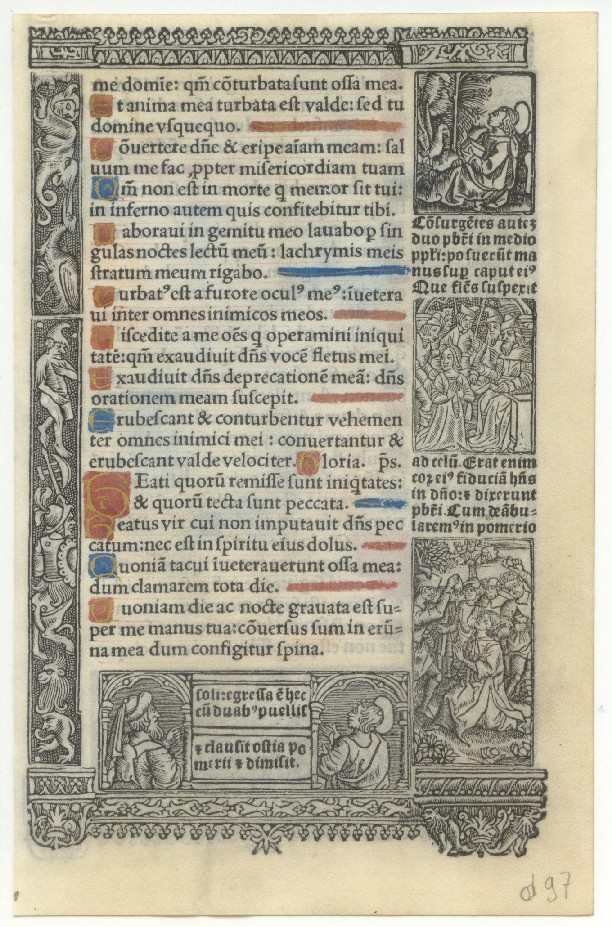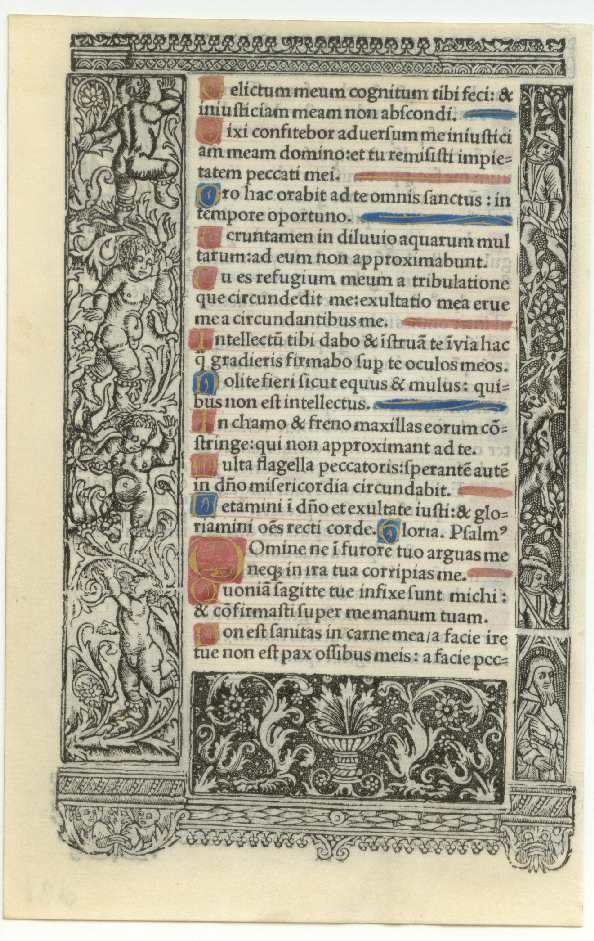|
The history of Susanna...
An early incunabulum ca 1500, printed and hand painted in Paris by Hardouin, who had his workshop near the Notre Dame.
At the end of the Middle Ages the art of printing was used for Books of Hours; but the appearance of the books had to be much like the manuscript editions of the ages in the past: the letters were copied from the scribes and the decorations were hand painted: So the initials and line fillers were coloured by hand in red, blue and gold.
Around the text is an architectural border and very vivid metal cuts: hunting scenes, biblical stories, fabulous animals, lots of putti [ obesitas seems to be a problem in the Middle Ages as well!!] and architectural drawings.
The captions of the pictures are from the history of Susanna* that we can find in the Apocrypha, Daniel 13.
But the two elders rising up in the midst of the people, laid their hands upon her head. consurgentes autem duo presbyteri in medio populi posuerunt manus super caput eius 13 35 And she weeping, looked up to heaven, for her heart had confidence in the Lord. quae flens suspexit ad caelum erat enim cor eius fiduciam habens in Domino.
13 36 And the elders said: As we walked in the orchard alone, this woman came in with two maids, and shut the doors of the orchard, ans sent away the maids from her. et dixerunt presbyteri cum deambularemus in pomerio soli ingressa est haec cum duabus puellis et clausit ostia pomerii et dimisit paellas.
*The history of Susanna and the two elders. This history of Susanna, in all the ancient Greek and Latin Bibles, was placed in the beginning of the book of Daniel: till St. Jerome, in his translation, detached it from thence; because he did not find it in the Hebrew: which is also the case of the history of Bel and the Dragon. But both the one and the other are received by the Catholic Church: and were from the very beginning a part of the Christian Bible.
The main text is from the psalms and I'll give you the transcription and translation of some text [ beginning on the recto, line 10 from the bottom ]: It is one of the Penitential Psalms*. Psalmus 31 (32)**
1 Ipsi David intellectus Beati quorum remissae sunt iniquitates et quorum tecta sunt peccata 1 To David himself, understanding. Blessed are they whose iniquities are forgiven, and whose sins are covered. 2 Beatus vir cui non inputabit Dominus peccatum nec est in spiritu eius dolus 2 Blessed is the man to whom the Lord hath not imputed sin, and in whose spirit there is no guile. 3 Quoniam tacui inveteraverunt ossa mea dum clamarem tota die 3 Because I was silent my bones grew old; whilst I cried out all the day long. 4 Quoniam die ac nocte gravata est super me manus tua conversus sum in aerumna mea dum configitur mihi spina 4 For day and night thy hand was heavy upon me: I am turned in my anguish, whilst the thorn is fastened. 5 Delictum meum cognitum tibi feci et iniustitiam meam non abscondi dixi confitebor adversus me iniustitiam meam Domino et tu remisisti impietatem peccati mei 5 I have acknowledged my sin to thee, and my injustice I have not concealed. I said I will confess against myself my injustice to the Lord: and thou hast forgiven the wickedness of my sin. 6 Pro hac orabit ad te omnis sanctus in tempore oportuno verumtamen in diluvio aquarum multarum ad eum non adproximabunt 6 For this shall every one that is holy pray to thee in a seasonable time. And yet in a flood of many waters, they shall not come nigh unto him. 7 Tu es refugium meum a tribulatione quae circumdedit me exultatio mea erue me a circumdantibus me 7 Thou art my refuge from the trouble which hath encompassed me: my joy, deliver me from them that surround me. 8 Intellectum tibi dabo et instruam te in via hac qua gradieris firmabo super te oculos meos 8 I will give thee understanding, and I will instruct thee in this way, in which thou shalt go: I will fix my eyes upon thee. 9 Nolite fieri sicut equus et mulus quibus non est intellectus in camo et freno maxillas eorum constringe qui non adproximant ad te 9 Do not become like the horse and the mule, who have no understanding. With bit and bridle bind fast their jaws, who come not near unto thee. 10 Multa flagella peccatoris sperantem autem in Domino misericordia circumdabit 10 Many are the scourges of the sinner, but mercy shall encompass him that hopeth in the Lord. 11 Laetamini in Domino et exultate iusti et gloriamini omnes recti corde 11 Be glad in the Lord, and rejoice, ye just, and glory, all ye right of heart.
*The Seven Penitential Psalms ( 6, 31, 37, 50, 101, 129 and 142) Let's hear what Roger S. Wieck has to say about these psalms in his wonderful book Painted Prayers : " These particular seven psalms have a long history associated with atonement. It is thought that by the third century, and probably much earlier, they had formed a part of Jewish liturgy. In the Christian tradition, they were certainly known by the sixth century, when the Roman author and monk Cassiodorus referred to them as a sevenfold means of obtaining forgiveness. (..) Since the number of these psalms was the same as the Deadly Sins, the two became linked, and the Penitential Psalms were recited to ask for forgiveness for the dead. Like the Office of the Dead, the psalms were thought especially efficacious in reducing the time the departed had to spend in purgatory. But it is also clear that the Psalms were recited to benefit the living, as a means of avoiding these sins in the first place. This was important because the Seven Deadly Sins - pride, covetousness, lust, envy, gluttony, anger and sloth - had the ability to land one in hell for all time. This is why they were called Deadly or Mortal." Medieval tradition ascribed them to King David, who composed them as a penance for his sins : adultery, murder and pride.
** Numeration of the Psalms. The Psalms in the Psalter are enumerated from 1-150 in Books of Hours. In the Authorised Version, however, Psalm 9 and Psalm 10 are combined to form Psalm 9; Psalms 114 & 115 are also conflated to form 113; and Psalm 116 is divided to form psalms 114 & 115. Thus the Book of Hours psalms 1-9 are represented by Authorised Version 1-10 , BOH 10 -113 are represented by Authorised Version 11- 115, BOH 114 -146 are represented by Authorised Version 116- 147. BOH 147-150 are represented by Authorised Version 147-150.
Size : 17 x 11 cm ( ca 7 x 4.5 ins); |


